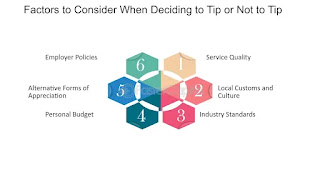To Tip or Not to Tip: A Modern Dilemma
Tipping, a practice that has evolved over centuries, has become an integral part of the service industry in many cultures. It is a gesture of appreciation for exceptional service, often supplementing the wages of workers who rely on customer generosity to supplement their income. While tipping is considered a standard practice in some countries, its prevalence and expectations vary significantly across different regions and industries. The origins of tipping could be traced back to medieval Europe, where it was customary to reward servants and workers for their services. Over time, the practice spread to other parts of the world and became more formalized. In the modern era, tipping has become a complex and often debated topic, with varying perspectives on its fairness, effectiveness, and impact on the service industry.
The concept of tipping has faced both praise and criticism. Proponents argue that it encourages excellent service, incentivizes workers to go above and beyond their duties, and fosters a positive customer-service relationship. Critics, on the other hand, contend that tipping can lead to income inequality, create an unfair burden on consumers, and perpetuate a system where workers' wages are heavily reliant on the generosity of customers.
The Current State of Tipping
In today's world, tipping remains a prevalent practice in many countries, particularly in the United States. However, its role and expectations have evolved in recent years, reflecting changing societal values and economic realities. While tipping is still widely accepted in the service industry, there has been a growing movement to reconsider its necessity and fairness. Critics argue that tipping can create an uneven distribution of income among service workers, as it relies heavily on the generosity of customers. Additionally, some believe that tipping can contribute to a culture of low wages for service industry employees, as employers may rely on customers to supplement their workers' salaries.
Despite these criticisms, tipping continues to be a common practice in many parts of the world. Factors such as cultural norms, industry standards, and individual preferences influence the extent to which tipping is expected and appreciated. As the debate over tipping continues, it is essential to consider the various perspectives and explore potential alternatives or reforms that could address the challenges associated with this practice.
Factors to Consider When Tipping
When deciding whether or not to tip, it's important to consider several factors that can influence your decision. One of the most crucial aspects is understanding local customs. Tipping practices vary significantly from country to country and even within regions. It's essential to research the cultural norms and expectations before traveling or dining out to avoid any misunderstandings. Another factor to take into account is the quality of service we receive. If we are satisfied with the service provided, a tip is a great way to express our appreciation. However, if we are disappointed with the service, we may choose to leave a smaller tip or none at all. This approach encourages service providers to strive for excellence and rewards those who deliver exceptional service.
Additionally, industry standards play a role in tipping expectations. Some industries have well-established tipping norms, while others may have more flexible guidelines. For example, tipping is generally expected in restaurants, but it may be less common in other service industries such as retail or transportation. It's helpful to familiarize yourself with the standard practices in the industry we are dealing with Finally, consider the business model of the establishment we are patronizing. Some businesses may include a service charge or gratuity on the bill, which can affect your tipping decision. If a service charge is included, we may not need to tip additionally. However, if the service charge is optional, we could still choose to tip based on the quality of service we receive.
Practical Guidelines for Tipping
Hotel Staff :- Tipping hotel staff is a common practice to show appreciation for their services. While not always mandatory, tipping is often expected for services such as room service, housekeeping, and bellhop assistance. A typical tip is $1-2 per bag for the bellhop and $2-5 per day for housekeeping. If we receive exceptional service from the hotel staff, we may choose to tip more generously. For example, if the housekeeping staff goes above and beyond to keep our room clean and tidy, or if the room service staff is prompt and courteous, a higher tip is appropriate.
The debate over tipping has intensified in recent years, with proponents and opponents presenting compelling arguments. Proponents of tipping argue that it is a crucial component of the service industry, incentivizing workers to provide exceptional service and supplementing their often low wages. They contend that tipping allows customers to directly reward employees for their hard work and dedication. Opponents of tipping, however, argue that it creates an unfair and inconsistent system where workers' income is heavily reliant on the generosity of customers. They contend that tipping can lead to income inequality and can place an undue burden on consumers, who may feel pressured to tip even if they are dissatisfied with the service.
Furthermore, opponents argue that tipping can discourage businesses from paying their employees a fair and living wage, as they may rely on customers to supplement their workers' income. This can perpetuate a cycle of low wages and job insecurity in the service industry.The rise of technology has introduced new dimensions to the tipping debate. Online platforms like food delivery apps and ride-sharing services have made it easier for customers to tip, but they have also raised questions about the fairness and transparency of the process. One of the main concerns with online tipping is the potential for tip pooling, where tips are shared among multiple workers rather than going directly to the individual who provided the service. This practice can raise questions about fairness and transparency, as it can be difficult for customers to know where their tips are going.
Another issue is the impact of technology on tipping culture. Some argue that the convenience of online tipping has led to a decline in face-to-face interactions, which can diminish the personal connection between customers and service providers. This, in turn, can affect tipping behavior, as customers may be less likely to tip generously if they don't feel a strong connection to the person providing the service. Despite these challenges, technology also offers opportunities to improve the tipping experience. For example, some apps allow customers to leave detailed feedback and ratings, which can help service providers identify areas for improvement and potentially increase their tips. Additionally, some platforms are exploring ways to ensure that tips are distributed fairly and transparently, such as by using tip pooling models that prioritize workers based on factors like hours worked and performance.
As technology continues to evolve, it is likely that the tipping debate will become even more complex. By understanding the challenges and opportunities presented by technology, we can work towards creating a more equitable and transparent tipping system for everyone involved.
My Opinion on Tipping
Rewarding Good Service: Tipping provides a tangible way for customers to acknowledge and appreciate exceptional service. By leaving a tip, customers can directly reward employees who go above and beyond their duties, motivating them to continue providing excellent service in the future. This can create a positive feedback loop where good service is rewarded, leading to even better experiences for customers.
Supplementing Wages: In many service industries, base pay can be relatively low. Tipping offers a valuable opportunity for employees to supplement their income, especially during peak times or when they provide additional services. This can help to ensure that service workers receive fair compensation for their labor and can improve their overall quality of life.
Building Relationships: Tipping can foster positive relationships between customers and service providers. When customers leave generous tips, it can create a sense of goodwill and appreciation. This can lead to repeat business, as customers may be more likely to return to establishments where they have had positive experiences. Additionally, strong relationships between customers and service providers can contribute to a more enjoyable and personalized experience for all parties involved.
Income Inequality: Tipping can contribute to income inequality among service workers. Because tips are often discretionary, employees' earnings can vary significantly based on factors such as customer generosity, shift length, and the popularity of the establishment. This can lead to disparities in income even among workers performing similar tasks, exacerbating existing inequalities.
Unfair Burden on Consumers: Tipping could place an undue burden on consumers, who may feel pressured to tip even if they are dissatisfied with the service. This can be particularly challenging for those on tight budgets or who have had negative experiences. Additionally, the expectation to tip could create a sense of obligation that may not align with the quality of service received.
Perpetuating Low Wages: Tipping can inadvertently perpetuate low wages in the service industry. Employers may rely on tips to supplement their workers' base pay, reducing their incentive to offer competitive wages. This can create a cycle where service workers are underpaid, and businesses continue to rely on tips to maintain their profit margins.
The debate over tipping is a complex one, with valid arguments on both sides. While tipping can be a rewarding way to show appreciation for good service and supplement the wages of service workers, it also has its limitations. As society continues to evolve, it is important to consider alternative models that could address the challenges associated with tipping. These might include living wages for all workers, service charges that are distributed fairly among employees, or a shift towards a tipping-optional system. Ultimately, the decision of whether or not to tip is a personal one. By understanding the pros and cons of tipping and considering the broader context, we could make an informed decision that aligns with our values and beliefs.












Comments
Post a Comment